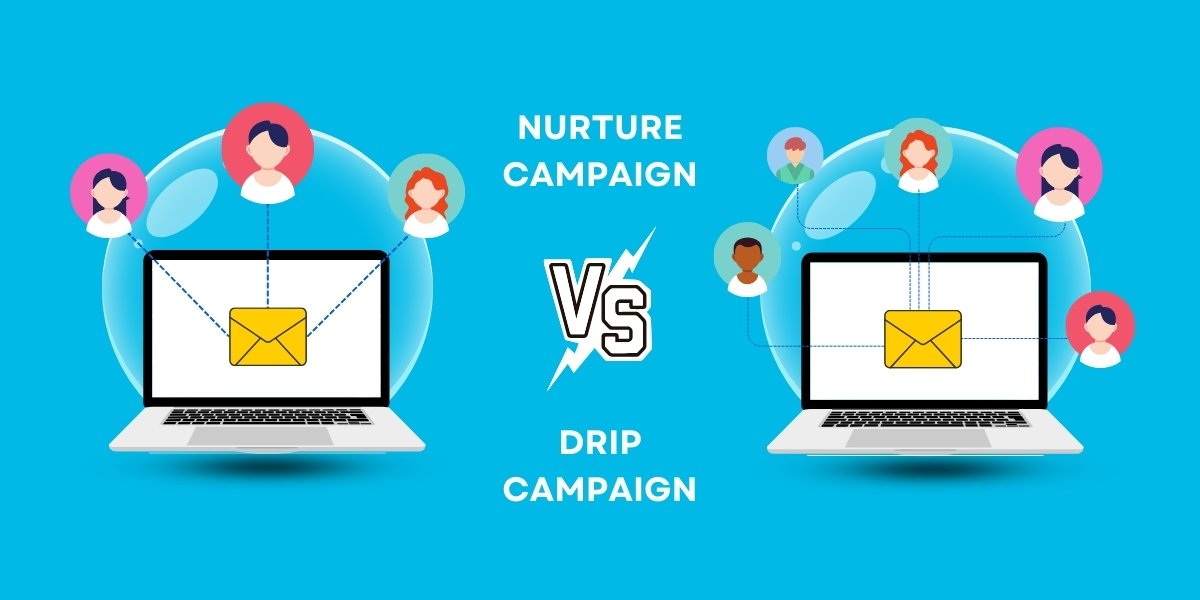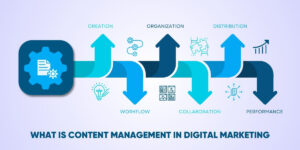Know the Difference between the Nurture Campaign vs. Drip Campaign
Email marketing remains one of the most effective ways to engage with prospects and customers. However, not all email campaigns are created equal. Two popular strategies with very different approaches are nurture campaign vs drip campaign. Which one should marketers use to maximize results?
The answer is that nurture and drip campaigns actually complement each other nicely. Smart marketers employ both as part of a comprehensive email strategy. In this article, we’ll look at what sets nurture and drip campaigns apart, when to use each approach, and how to execute both types effectively.
First, let’s clearly define what nurture and drip campaigns are at their core.
Key Takeaways
- Nurture campaigns focus on providing relevant, personalized content to leads based on their interests and actions. Drip campaigns send scheduled emails to move prospects through a sales funnel.
- Nurture campaigns are better for building relationships, educating prospects, and staying top-of-mind. Drip campaigns excel at converting leads by prompting specific desired actions.
- The best approach combines nurturing and drips. Use nurture streams to attract and engage cold leads, then transition warm leads to drips to convert them into customers.
- Set up nurture streams based on lead attributes and behaviors. Tailor content to interests and send when triggered by actions.
- Create drips with a timeline of emails to encourage prospects down the funnel. Tailor messaging and offers to the prospect’s stage.
- Analyze email metrics like open, click-through, and unsubscribe rates. Adjust campaigns based on performance data. A/B test content and timing.
Nurture Campaign vs Drip Campaign: A Quick Comparison
| Feature | Nurture Campaign | Drip Campaign |
|---|---|---|
| Goal | Build relationships and educate prospects | Convert leads by prompting actions |
| Segmentation | Based on attributes like demographics, interests, behavior | Based on sales funnel stage |
| Content | Educational, tailored to segment interests | Promotional, matched to buyer journey stage |
| Timing | Triggered by user actions and behaviors | Scheduled at pre-defined intervals |
| Length | Ongoing while prospect is engaged | Typically 4-8 emails over 1-4 weeks |
| Metrics | Click-through rate, assist rate | Conversion rate, sales attribution |
| Personalization | Highly personalized content | Semi-personalized messaging |
| Automation | Semi-automated based on behaviors | Fully automated workflow |
| Audience | Colder prospects needing education | Warmer prospects ready to buy |
| Touchpoints | Uses emails plus ads, social, etc. | Primarily email-based |
| Flexibility | Leaner – easier to adjust on the fly | More regimented – onboarding required |
| Best For | Relationship building over extended period | Driving conversions over defined timeline |
What Are Nurture Campaigns?
Nurture campaigns, also called nurture streams, focus on building relationships with subscribers by providing relevant, personalized content tailored to their specific interests and needs. They take a more organic approach to engaging cold leads in order to warm them up for future sales conversations.
With nurture campaigns, you group contacts into segments based on explicit data like demographics and behaviors or implicit signals like page views. You then create a custom email series with educational content mapped to each segment’s interests and goals.
For example, new contacts who have downloaded an introductory content offer may be added to a nurture stream that sends a series of helpful follow-up emails with more tips and insights related to that topic.
The idea is to nurture subscribers by providing ongoing value. As you demonstrate expertise and establish trust, contacts warm up to your brand. At that point, they can transition from the nurture stream to your sales funnel.
What Are Drip Campaigns?
Drip campaigns, sometimes called drips or drip series, take a more direct approach. They focus on converting leads by prompting specific actions that move prospects down the sales funnel.
With drip campaigns, you first build out an email sequence that corresponds to different stages in your sales process. For example:
- Welcome email
- Product demo sign-up
- Discount coupon
- Free trial invite
- Resources for evaluating solutions
- Final call to purchase
As leads enter your sales funnel, you enroll them in the automated drip series based on their conversion stage. The key is matching the messaging and offers in each email to the recipient’s expected mindset as they progress.
Drips are time-based and deployed according to the schedule you set. The emails act as prompts, pushing contacts closer to a conversion event with each scheduled interaction
Comparing Nurture vs. Drip Campaign Approaches
To summarize the core differences:
Nurture Campaigns
- Segment contacts based on attributes and behaviors
- Send hyper-targeted content matched to segment interests
- Focus on relationship-building through ongoing value
- Take an organic approach with no set timeline
Drip Campaigns
- Group contacts by where they’re at in the sales funnel
- Send a pre-defined sequence of emails on a set schedule
- Focus on prompting specific actions to convert leads
- Take a direct approach based on a conversion timeline
What are the Benefits of Nurture Campaigns
Nurture campaigns bring several advantages that make them highly effective for moving cold prospects through the top and middle stages of your sales funnel:
They Allow You to Tailor Content to Each Contact’s Interests
With nurture emails, you can create streams that align with different segments based on demographic data, firmographics, page visits, content downloads, and more. This enables you to provide subscribers with personalized content that resonates with their needs and interests.
Sending targeted, relevant information builds relationships. Prospects pay more attention to emails when the subject matter relates to them. Hyper-personalization also helps your brand stand out from other generic emails subscribers receive.
They Keep Your Brand Top-of-Mind
Nurture streams are designed to engage prospects with valuable content over an extended period. By consistently providing helpful information, you stay on subscribers’ radar screens and build mindshare. Even if leads still need to be ready to buy, your brand remains fresh for future consideration.
They Educate and Inform
Quality content sharing insider knowledge helps establish your company as an expert. Nurture emails allow you to provide broader value beyond just selling. Educating prospects makes them more likely to think of your brand when they are ready to make a purchase decision.
They Build Trust
When subscribers receive ongoing value tailored to them, it demonstrates that you have their best interests in mind. Nurturing leads with insightful content shows that you genuinely want to help, not just sell to them. This fosters trust in your brand as a partner rather than just another vendor.
They Allow You to Stay in Touch With Cold Leads
Leads enter your funnel with varying levels of interest. Nurture streams let you continue engaging with colder prospects by providing helpful info that brings them closer to your brand. Warming up leads for future sales is better than ignoring them and potentially losing touch.
They Give You Flexibility With Timing
Since nurture emails are triggered based on subscriber actions, they work on the prospect’s timeframe rather than yours. Contact can control the pace of communication based on how they engage. This organic, lead-driven approach allows you to connect when the prospect is most receptive.
What are the Benefits of Drip Campaigns
The structured nature of drip campaigns also makes them highly effective for email marketers, but in different ways:
They Allow You to Target Messaging Based on Funnel Stage
Because drips correspond to different phases in your sales process, you can tailor the messaging, offers, and calls to action in each email based on where contacts are in their buyer journey. This helps frame information in a relevant way.
For example, someone who just signed up for a demo may receive an email with pricing info and the next steps to purchase. Contacts who have already bought get drips focused on customer success and retention.
They Automate Your Follow-Up Communication
With drips, you define the timeline and sequence in advance. Once configured, they deploy automatically when the associated actions occur. This saves a ton of manual work trying to monitor and follow up with every new lead.
They Keep Leads Moving Toward Conversion
The scheduled nature of drips provides continual gentle nudges to contacts. With each email, you can encourage the next logical step to advance prospects closer to converting. This prevents leads from stalling and helps them progress through your funnel.
They Allow You to Promote Offers and Events
Drip campaigns are a vehicle for highlighting time-sensitive promotions, discounts, events, and other opportunities. A scheduled cadence ensures that messages reach the right audiences at the optimal times to generate interest.
They Can Accelerate the Path to Revenue
Used well, drip series capitalize on campaigns and events to increase conversions. The prompted calls to action can help you capture more leads and sales compared to simply waiting on organic engagement alone.
They Enable Consistent Follow-Up
It can be challenging to remember to follow up with all your new leads. Drips ensures that every contact gets the same timely communication based on hitting specific triggers, so no one falls through the cracks.
To wrap up drips provide structured automation to usher leads toward conversion goals consistently and reliably. However, this is optimized when contacts are already warmed up and engaged.
Combining Nurture and Drip Campaigns
Now that we’ve looked at the distinct advantages of nurture and drip campaigns, most marketers would conclude that the two approaches complement each other quite nicely.
The best practice is to leverage nurture streams and drips together as part of your overall email strategy. Here are some tips on how to combine them effectively:
Use Nurturing to Attract and Engage Cold Leads
Focus your nurture emails on educational content to bring in new subscribers and build relationships with them over time. Great offers to start nurture streams include:
- Downloading a report or ebook
- Signing up for a newsletter
- Attending a webinar
Send relevant follow-up emails when someone engages with these offers to keep providing value. Nurture cold leads until they are warmed up.
Transition Warm Leads to Targeted Drip Campaigns
Once prospects are engaged, transition them from the nurture stream to a drip campaign matched to their conversion stage to prompt the next steps.
For example, contacts who have shown interest by visiting pricing pages can move from a nurture series to a drip focused on demos and free trials. Contacts who attend a product webinar can shift to a drip with special offers to incentivize purchases.
Tailor Nurture Content to Specific Segments
Divide your coldest leads into distinct streams based on characteristics like role, industry, interests, geography, firmographic data, etc. Develop content that resonates with each group’s needs.
Send targeted emails when triggered by relevant behaviors like visiting certain site pages. This hyper-personalization makes nurturing as effective as possible.
Match Drips to Funnel Stage
Design unique drip campaigns that align with your sales process. Tailor the messaging and offers in each email based on where contacts are in their buyer journey.
For example, post-purchase drips can focus on adoption, training, and support. Meanwhile, bottom-funnel drips for leads evaluating solutions would provide comparisons and peer perspectives.
Use Lead Scoring to Determine Sales Readiness
Set up lead scoring rules that track engagement across email, site activity, events, and other channels. When prospects hit threshold scores, they indicate readiness to convert. Use this to determine when to transition warm leads from nurtures to drips.
Monitor Metrics to Optimize Continually
Pay close attention to email success metrics for your nurture and drip streams. Look at open, click-through, and unsubscribe rates. See which segments and campaigns perform best. Use this data to refine your approach for maximum results.
Following these best practices will enable you to combine the relationship-building benefits of nurturing emails with the conversion focus of drips. Now, let’s look at some examples of effective campaigns.
Examples of Highly Effective Nurture Campaigns
Here are a few examples of how top brands leverage nurture emails to attract, engage, educate, and convert subscribers:
Custom Audiences allow precise targeting of known contacts, while Lookalikes find audiences that probabilistically match desired traits.
Slack’s Welcome Series
When someone signs up for Slack’s communication app, they automatically get added to Slack’s Welcome Series nurture stream. This includes 5 emails over the user’s first 2 weeks highlighting key features, integrating other tools, and connecting with teammates to boost engagement.
These nurture emails help new users successfully get started with Slack right away to create sticky adoption. Users can also opt out of the stream at any point.
Shopify’s Abandoned Checkout Nurturing
If customers abandon their shopping cart on Shopify’s ecommerce platform, Shopify automatically triggers a series of abandoned cart nurture emails.
The first email, with a reminder, goes out 1 hour after the prospect abandons their cart. Additional emails providing exclusive discounts are sent 1 day later and 3 days later to entice the prospect to complete their purchase.
MongoDB’s Educational Nurturing
MongoDB sends a series of tailored nurture emails to developers focused on education. Email topics include technical guides, best practices, use cases, integrating MongoDB, and more.
This helps developers get more value from MongoDB, whether they are new learners or seasoned pros. Nurturing developers boosts brand awareness and loyalty.
Drift’s Event-Based Nurturing
Drift creates event-specific nurture streams around its content. For example, contacts who register for a webinar get a series related to that webinar topic before and after the live event.
This allows Drift to provide relevant education to prospects on whether or not they ultimately attend the webinar live. The nurture stream keeps the conversation going.
Mailchimp’s cabbages User-Specific Nurturing
Kabbage creates highly targeted, personalized nurture streams based on the user’s business. For example, retailers may receive content about inventory management and brick-and-mortar shops, while service providers may receive information on project management.
This hyper-personalized approach makes the nurture emails extremely relevant to each subscriber to build strong connections.
These examples showcase how leading brands creatively develop nurture streams matched to different segments, events, and actions. The right nurturing attracts and engages the right leads.
Examples of Highly Effective Drip Campaigns
Now let’s look at some examples of advanced drip campaign strategies that drive conversions:
Amazon’s Post-Purchase Drip Series
After customers complete purchases on Amazon, they are automatically enrolled in a drip campaign focused on stellar post-purchase experience.
Emails cover order confirmations, shipping updates, delivery notifications, reviewing products, loyalty programs, and more. This helps Amazon continue engaging with customers post-sale.
AppSumo’s Sumo Welcome Series
When new subscribers join the deals site AppSumo, they receive the Sumo Welcome Series over three days, which includes tips on getting the most value out of membership.
The low-pressure drips focus on success rather than upselling. This builds initial loyalty rather than overwhelming new users with promotions.
YouTube’s Weekly Watch Drip
YouTube analyzes viewing behaviors to determine user interests. It then automatically enrolls users in weekly drips highlighting recommended videos on topics they like.
This tailored content keeps users engaged on the platform longer and trains YouTube’s algorithms.
Dropbox’s Activity-Based Drips
Dropbox creates drips targeted to where the user is in their customer lifecycle. New user emails focus on product onboarding and training. Active user drips provide tips for advanced features.
Winback drips go to inactive users to reengage them. Lifecycle drips match user behaviors.
HubSpot’s Smart Lists and Workflows
HubSpot allows the creation of automated drips targeting “smart lists” that dynamically update based on criteria like form submissions, content views, etc.
Users can build drips to trigger immediately or on delays after contacts match rules. This powers highly customizable workflows.
These examples demonstrate how top brands map drips to their sales processes to nudge subscribers into desired actions after they are initially nurtured. Dynamic segmentation and clever design drive conversions.
Now, let’s look at some best practices for measuring the effectiveness of your campaigns.
How to Measure the Success of Nurture & Drip Emails
To continually refine your approach, you need to actively track, analyze, and compare metrics for both your nurture and drip campaigns. Here are key email success benchmarks to monitor:
Open Rates
Monitor overall open rates, as well as open rates for specific campaigns, streams, lists, and segments. Look for any with consistently low opens that may need content re-targeting.
Click-Through Rates
Pay attention to both the overall click rate and the click-to-open rate. Look for emails, offers, subject lines, and streams with low click engagement that could be improved.
Bounce Rates
Keep an eye on hard and soft bounces. A growing bounce rate may signal quality issues with your email list that require attention—segment to identify any problem subgroups.
Unsubscribe Rates
Review unsubscribe rates for both individual campaigns and the overall campaign. Rising unsubscribes can indicate relevance issues or contact fatigue, requiring nurture adjustments.
Conversion Rates
For drips, analyze the percentage of contacts successfully moving through each conversion funnel stage compared to those stalling out. Look for any sticking points in the drip series.
Engagement by Segment
Compare open, click, and unsubscribe rates for different lead segments. Identify best-performing groups to model future nurturing after. Optimize campaigns for lagging segments.
Email-Driven Conversions
For drips, examine the percentage of conversions that can be attributed directly to a drip email campaign vs. other channels. Rising attribution indicates an effective drip approach.
Channel Assists
For nurtures, look at conversions where nurture emails assisted along with other channels. High email assists indicate nurtures are contributing to pipeline development.
Analyzing this data will reveal optimization opportunities and help quantify the impact of your nurturing and drip strategies. Use insights to refine your campaigns.
Now, let’s discuss some tips for taking your efforts to the next level.
Advanced Tactics to Boost Results
Once you have the basics down, here are some proven tactics to further enhance your nurture and drip campaigns:
- Leverage AI and machine learning for content recommendations and stream assignments.
- Use progressive profiling to update lead attributes and behaviors to improve personalization continually.
- Incorporate dynamic content to customize emails for each recipient.
- Set up A/B testing to compare subject lines, content, layouts, timing, and other variables.
- Coordinate nurture and drip emails with ads, social messages, an
- Coordinate nurture and drip emails with ads, social messages, and direct mail for an omnichannel approach.
- Sync your email campaigns with webinars, events, and promotions to generate more interest.
- Employ lead scoring and lookalike modeling to identify engagement patterns and prospects with high conversion potential.
- Automate lead prioritization, stream-entry, and sales hand-offs based on email engagement data and scores.
- Conduct periodic list cleaning to remove hard bounces and inactive contacts.
- Send win-back and re-engagement campaigns to renew interest among stagnant subscribers.
- Evaluate free trials before auto-enrolling trial users in post-purchase drips.
- Conduct surveys and interviews with subscribers to gain feedback on improving email content.
- Maintain CAN-SPAM compliance with opt-outs, address lists, and sending frequency.
Implementing advanced nurture and drip strategies like these will enable you to continually refine and enhance results as you learn more about your audience and their buyer journey patterns.
Now, let’s look at some frequently asked questions from marketers about nurturing and drip campaigns.
Final Thoughts
Facebook Custom and Lookalike Audiences provide powerful ways to zero in on your ideal target audience. Custom Audiences allow you to re-engage directly with existing customers. Lookalike Audiences enable you to expand your reach to new potential customers.
Using both together can maximize your Facebook advertising performance and give you a “second bite at the apple” with people similar to current customers—Focus Custom Audiences on conversions and Lookalikes on top-funnel growth.
Be sure to analyze performance frequently and refresh your audiences with up-to-date data. With some optimization, you can achieve fantastic ROI by leveraging Facebook’s unique ability to apply your first-party data for razor-sharp targeting.
The combination of Custom and Lookalike Audiences gives you zero waste reach of potential customers on the world’s largest advertising platform. Utilize them together as part of an effective Facebook marketing strategy.
FAQs
What tools do you need to run effective nurture and drip campaigns?
It would help if you had an email service provider or marketing automation platform capable of:
- Segmenting based on lead attributes and behaviors
- Setting up automated email workflows and trigger-based sending
- Tracking opens, clicks, and conversions by campaign
- A/B testing email content variations
- Integrating with your CRM, email, and other Martech systems
What’s the best number of emails in a drip campaign?
Ideally, limit drops to 4 to 8 emails over a 1—to 4-week period. Avoid overly long drips that risk disengaging contacts. Prioritize the most critical conversion actions in the timeline.
How often should you send nurture emails?
Time nurture email frequency based on consumer preferences for your industry. Typically, sending 1 to 2 emails per week works well. Monitor unsubscribe rates and make adjustments.
Should nurture and drip emails come from an individual or general address?
General email addresses like support@company.com often have higher deliverability. However, using a sales rep’s email can boost the number of opens by the contacts they’re nurturing. Test both approaches.
How do you get sales reps to help with emails?
Educate reps on the value of digital follow-ups to reinforce outreach. Make it easy to upload contacts. Share program metrics. Publicly recognize top campaign contributors.
Should you A/B test emails for drips or nurtures?
Yes, test key elements like subject lines, content formatting, calls to action, timing, and lists for both nurtures and drips. Even slight messaging tweaks can impact performance.



